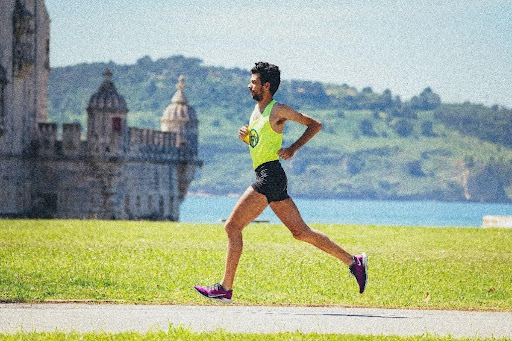Fitness for Long Distance Running
Endurance work is all about improving the cardiovascular system so as to increase your VO2 max which is a measure of aerobic fitness.
You also want to increase the pace you can sustain running at anaerobic threshold and develop the muscles throughout the body to cope with the rigours of a race. By improving all of these things you will simultaneously improve your running economy (how efficient you are when you run at a given pace).
Predominantly these improvements will be achieved through aerobic endurance running, although early in a training cycle some cross-training with cycling, swimming, team sports or other aerobic work can reduce the risk of overuse injuries and give a psychologically easy and fun break.

Photo Road training
Aerobic endurance training can be split into different types. Running continuously at a constant speed, also known as a ‘steady’ or ‘easy’ running, tempo running, fartlek training and intensive aerobic interval sessions.
Continuous running – the 'steady' or 'easy' run
This is the most common activity you will see from most distance runners - it forms the "bread and butter" training for endurance runners and is often what people enjoy doing the most. The length of the run and number of runs in a week will vary according to the distance being trained for and the past history of the athlete. Most athletes will intersperse their session days with a steady run, with some also completing one on the day of the session itself (either before or after depending on the session time), known as a double training day. Many runners will also include a longer steady run each week (often performed at the weekend). Depending on the athlete and event this can range from anywhere between 10 to 20 miles.
Approximately, for many athletes, half to two-thirds of the distance covered in the course of a week will be this kind of running.
Tempo Running
This is a sustained running effort that is aimed at building up your body’s ability to run faster for longer. This is by running at a pace that is just below your anaerobic threshold so that your body is still producing energy aerobically (after you cross this threshold your body starts producing energy anaerobically causing lactate build-up). By training at this pace, it helps to increase your anaerobic threshold so that you are able to sustain a faster pace before crossing it.

Photo Woman running
Tempo runs normally last between 10 and 40 minutes depending on your fitness and experience. This means if you are pushed for time, they are a really good way of getting in a hard workout. Tempo runs can also be split into interval sessions and performed as one of your key sessions of the week, for example 3 x 10 minute tempo blocks with a 2 minute recovery jog between.
The tempo pace is hard to gauge, typically described as running at a 'comfortably uncomfortable pace'! Essentially it should not be an all-out effort that leaves you on the floor after, but equally not feel easy either. A rough marker can be through heart rate, tempo running should be done at roughly 85 – 90% of maximum heart rate (maximum heart rate is calculated by 220 – your age). If you do not like to work with heart rate, tempo pace is also considered as somewhere between your 10km and half marathon race pace.
Fartlek training
Fartlek is a Swedish word meaning speed play, therefore the point of a fartlek session is to run at different speeds throughout the run, teaching your body to adapt to pace changes and helping you become faster over longer distances.
Essentially it is steady running with varied paced intervals. For example, you might do 2 minutes of easy running alternating with 1 minute of hard running for the duration of the run. Alternatively, you might choose to dictate the intervals by distance run.

Photo Running in the park
This is a great way to spice up your normal continuous run as it keeps your mind focused throughout. Or, you can see it as one of your main sessions for the week as it is one of the best ways to improve your endurance. Constantly changing pace challenges your body far more than keeping a consistent one and the lack of passive recoveries builds your fitness. Furthermore, the frequent change in pace with constant surges replicates a race situation, helping prepare your body for the demands of racing. It is also highly adaptable as a session as you can tailor it to make it incredibly high intensity through longer fast segments and shorter ‘recovery’ slower segments or make it lower intensity with longer ‘recovery’ periods.
Intensive Aerobic Interval Sessions
This is about running interval repetitions (shorter than your race distance) at, or faster than, race pace. This is to raise your aerobic fitness levels so that you can increase the overall speed at which you are able to complete the distance of the main event.
It is very hard to generalise about what sessions people should do, but typical sessions could include reps of 800m or 1000m with a minute or two between each rep. Sessions can include mixtures of rep distances to constantly demand pace changes or stick with the same rep distance throughout to promote training at a consistent pace. The total volume of the session would depend on the experience and fitness of the individual, but might be around 8km for a good adult club athlete. The recoveries should be short, and, for more experienced runners should be active, either as a steady walk or recovery jog.
Most of these reps would be at about race pace or faster for a 5k or 10k, making allowances for the weather conditions etc.
Other types of sessions would include pyramids, split/paired intervals or sets of runs.
A pyramid might have runs getting longer and then shorter (e.g. 800-1000-1200-1600-1200-1000-800) or just go one way (e.g. 1000-900-800-700-600), the aim might be to run all the reps at the same pace, or alternatively to increase the speed on the shorter reps.

Photo Track training
Split/Paired Intervals would normally be reps where there is a shorter rest between each of the reps and more between the pairs - for example 6 x 2 x 400m with 30secs between each rep and then 3 minutes between the sets. The distances might vary (e.g. the first one could be 800 and the second 400 in each pair)
Finally, sets are like pairs, but with more reps in each set. This allows a better recovery (and subsequently a faster pace) after the long rests. An example might be 3 x 5 x 600m with 1 minutes between each rep and 4 minutes between the sets.
For those without access to a track, these sessions can be mimicked through using timings as opposed to distances. For example you could have a pyramid session like 2x2 minutes, 2x3 minutes, 2x6 minutes, 2x3 minutes, 2x2 minutes all with 90 seconds recovery. Or instead of 6 x 1 mile you can do 6 x 6 minutes.
Sessions run to time can be helpful as they allow for daily training fluctuations, e.g. on a good day you will cover a lot more distance in the rep times compared to a day where you are fatigued. Additionally often the pacing of a rep run for time is a lot more consistent as there is no definite endpoint avoiding that last minute dash to the line, this means your effort is better distributed throughout the reps meaning that by the end you will have emptied the tank!
Overall a mixture of sessions run to time and to distance is good for your training plan to keep things varied and challenging.
